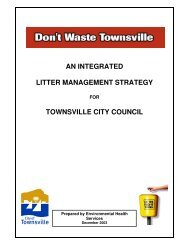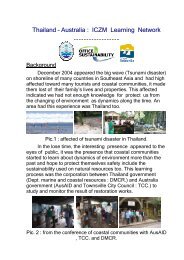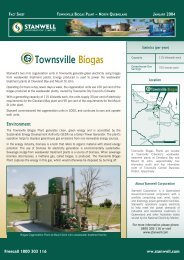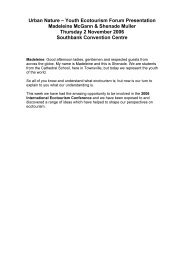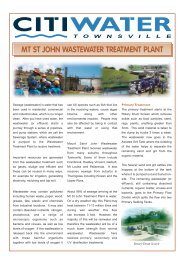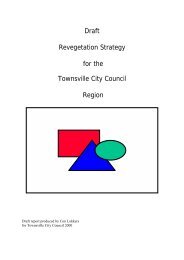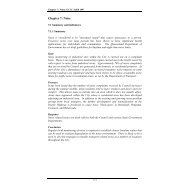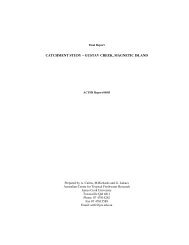ENVI RONMENTAL HI STORY OF ROWES BAY - Townsville State ...
ENVI RONMENTAL HI STORY OF ROWES BAY - Townsville State ...
ENVI RONMENTAL HI STORY OF ROWES BAY - Townsville State ...
- No tags were found...
Create successful ePaper yourself
Turn your PDF publications into a flip-book with our unique Google optimized e-Paper software.
Environmental history of Rowes Baythe ridge, and much of it has been landscaped for park areas. At its southernmost extent in RowesBay, the modern beach formerly consisted of several small, highly mobile sand spits at the mouthsof two small creeks (see Section 6).The modern beach ridge has been in place for at least ~1000 years, having formed when the olderand younger beach ridges had built out to fill the embayment to the end of Many Peaks Range.Although shoreline progradation then ceased, sand supply to the embayment would have continued,and this would still have been worked northwards, but would be able to leave the embayment pastCape Pallarenda. Over time a steady-state would be maintained, and the shoreline would remain ina relatively stable position. Periods of erosion would occur during cyclones, or when sand supplyfrom Ross River slowed. However, these would be followed by periods of beach recovery whensand supply was re-established and/or wave energy levels were lower and more conducive to beachaccretion. This pattern of beach behaviour can be seen in the area south of Three Mile Creek overthe last 30 years. During Cyclone Althea in 1971, ~15 m of beach erosion occurred, but since thenthe shoreline has built out more than 20 m. However, this process can only occur if there is acontinuing supply of sand to the embayment.3.3 Origin and Movement of Sand in the Kissing Point-Many Peaks Range EmbaymentThe origin and movement of sand in the embayment is crucial to understanding the erosionproblems that are occurring in Rowes Bay today. Three issues are important:• Where has the sand come from?• What transport processes have moved the sand?• Where was this transport process occurring?The ultimate source of sand in the Rowes Bay beach ridges is Ross River. As the sand ispredominantly composed of quartz, it must have been derived from erosion of the mainland. Theonly river of suitable size and proximity to transport the sand to the coast is the Ross River.Originally, the river had two mouths, with a small flood channel discharging through Ross Creekand the main mouth 2 km to the southeast. Sand would have been delivered to Cleveland Baythrough both mouths, forming large sand bars. The delivery of sand would have been episodic,occurring mainly during floods.Once at the river mouths, the sand would have been re-distributed by wind-driven wave processes,and as the dominant winds are from the southeast, the direction of transport would have been to thenorthwest towards Kissing Point. Observations of the sediment distribution in Cleveland Bay showthat sand-sized sediments are distinctively confined to the upper intertidal zone on the beach face.Thus, movement of sand from the Ross River occurs predominantly along the beach face by theprocess of longshore drift.Today, two of these three natural processes have been interrupted. Ross Creek is no longer a mouthof Ross River, and the weirs and dam upstream have reduced the size of floods. Thus, there is agreatly reduced volume of sand being carried to the coast. The port facilities have been builtdirectly across the upper intertidal zone, blocking the movement of any sand along the shore fromthe river mouth. However, the sediment transport processes are still occurring, and there is now animbalance between the supply of sand to the beaches, and the levels of wave energy that are seekingto move sand along the shore. This negative sediment budget results in beach erosion.3.4 Long-term/natural Sand Budget for the EmbaymentThe above analysis of the landforms, sediments, and sand transport mechanisms allows a long-termsediment budget to be established. A sediment budget quantifies the volume of sand movingthrough a beach system, and can be used to determine the amount of sand supply required tomaintain the shoreline in a long-term steady state condition. The long-term sediment budget for theembayment can be modelled as follows.4



